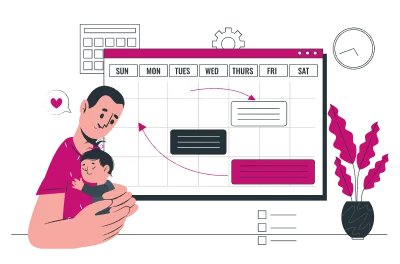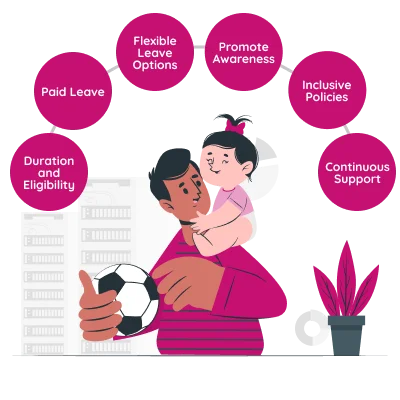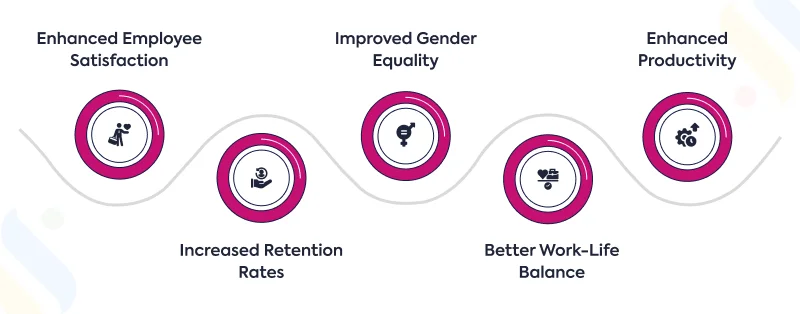
Not only does maternity leave matter, but paternity leave in India is important too.
In recent years, the discussion around paternity leave for men has gained significant traction globally.
While maternity leave has been around for a while, paternity leave is slowly becoming a topic of discussion. Paternity leave is crucial for gender equality, family bonding, and the overall well-being of both parents and the baby.
In India, paternity leave application is still evolving and many private companies are starting to recognize its importance. This ultimate guide will help you understand paternity leave in India for male, its importance, benefits, and best practices to implement a paternity leave policy.
What Is Paternity Leave?

The period of leave granted to a father after the birth of his child is called paternity leave. These paternity leaves are intended to allow fathers to spend time with their support their partners, and newborns, and participate in early child-rearing activities.
Unlike maternity leave paternity leave is not widely recognized. The paternity leave policies vary significantly across different countries and organizations. The concept is rooted in the belief that both parents play a crucial role in a child’s development. In this case, fathers should be allowed to bond with their children and support their partners.
Achieve 99% accuracy in leave tracking with Super HRMS!
Now reduce extra time for leave management by using automated tools.
The Scenario of Paternity Leave Rules in India

In the Indian leave management system, paternity leave is still growing compared to maternity leave. The Indian Maternity Benefit Act, of 1961, mandates maternity leave for women, but there is no equivalent statutory provision for paternity leave.
However, recognizing the importance of fathers’ involvement in early childcare, some private companies have started to introduce paternity leave policies.
Since there is no law governing paternity leave in India, the duration and paternity benefits vary across employers. Some companies offer paternity leave from a few days to several weeks while others offer leave management system online at all.
Is paternity leave mandatory in India? the answer is – NO. That’s why there is no paternity policy. The lack of uniformity in paternity leave policies means all working fathers in India need a standardized approach.
Scope & Best Practices of Paternity Leave Policy in India

To create an inclusive and supportive work environment, organizations need to implement effective paternity leave policies. Here are some best practices for establishing a comprehensive policy of paternity leave in India:
– Define The Duration and Eligibility
In the leave policy, specify the duration of paternity leave and the eligibility criteria.
A typical paternity leave period can range from 2 to 4 weeks. This allows new fathers to support their spouses and spend quality time with their newborns.
By providing a reasonable duration of leave, companies can ensure that fathers have enough time to bond with their children.
– Paid Leave
For the advantage or further benefits, ensure that paternity leave is paid to encourage more fathers to take advantage of it.
Consider the paternity leave application format that alleviates financial concerns and promotes the active involvement of fathers in childcare. When fathers are given paid leave, they are more likely to take the time off, which can lead to better family dynamics and support for the mother.
Paternity leaves can also reduce stress and anxiety for new fathers, allowing them to focus on their family responsibilities.
– Flexible Leave Options
Give flexibility on how paternity leave can be taken. For example, allow dads as to how many days paternity leave they want. Or they take leave consecutively or in chunks, whatever suits them and their situation.
This flexibility can cater to different family situations and work schedules so dads can manage their work and personal lives better. By giving flexible medical leave application format options, companies can show they care for their employees’ diverse needs and work-life balance.
– Promote Awareness
The paternity policy promotes a culture that encourages fathers to take leave without fear. Educate employees about the availability and importance of paternity leave.
Awareness campaigns and training sessions can help dispel myths and misconceptions about paternity leave.
Companies can ensure that employees feel comfortable taking the leave tracking tool they are entitled to.
– Inclusive Policies
Extend paternity leave benefits to adoptive fathers to ensure inclusivity and equal treatment for all employees.
Inclusive policies demonstrate a company’s commitment to all employees.
– Continuous Support
As per the best practices, you can offer resources and support for new fathers, such as counseling services, parenting workshops, and flexible work arrangements. This helps them balance their professional and personal responsibilities.
Benefits of Having Paternity Leave in India for Private Companies

Implementing paternity leave in India can bring numerous benefits to private companies, including:
– Enhanced Employee Satisfaction
Providing paternity leave in the private sector demonstrates that the company values work-life balance and supports its employees’ family needs. Employees feel satisfied as the company is providing something important to take care of their family.
When employees feel that their employer cares about their family, and get leaves as weeks of paid leave they feel satisfied. They feel motivated to work honestly in the organization.
– Increased Retention Rates
Offering paternity leave application mail to government employees and private company male employees can help reduce employee turnover rates by retaining talented employees. When employees are supported during significant life events, they are more likely to stay with the company long-term in private companies.
Retaining experienced employees reduces recruitment and training costs, and maintains organizational stability. A supportive employee leave policy can be a key factor in employee retention.
– Improved Gender Equality
Encouraging fathers to take paternity leave promotes gender equality. It challenges traditional gender roles and sharing childcare responsibilities more equitably. By supporting both parents in their caregiving roles, companies can help dismantle stereotypes.
This policy can lead to a more balanced distribution of household responsibilities, empowering women to pursue their careers and reducing gender disparities in the workplace.
– Better Work-Life Balance
Paternity leave allows fathers to balance their work and family responsibilities more effectively. The policy is used to reduce stress and improve the overall well-being of employees. When employees can take time off to be with their newborns, they are less likely to experience burnout.
Supporting work-life balance can also lead to better mental health and job performance. Employees can focus on their tasks without being overwhelmed by personal responsibilities.
– Enhanced Productivity
Employees who feel supported in the company will be more focused. By offering paternity leave, companies can help employees manage their family obligations.
When employees know they have the support of their employer, they are more likely to remain committed.
Eligibility for Paternity Leave: Paternity Leave Rules

The eligibility criteria for paternity leave maternity leave can vary depending on the company’s policies. You can add the criteria in policy by using Top HRMS software. However, some guidelines include:
1. Employment Status
Paternity leave is typically available to full-time and permanent government employees as well. Some companies may also extend the benefit to part-time or contractual employees. By ensuring services employee leave tracker for all types of employees have access to paternity leave.
2. Tenure
Employees may need to have completed a minimum tenure with the company, such as one year, to be eligible for paternity leave. This requirement ensures that employees have established a level of commitment and contribution to the organization.
3. Documentation
Employers may require documentation, such as a birth certificate or medical certificate, to verify the birth of the child and grant paternity leave.
Clear guidelines on the required documentation can help streamline the leave status process and reduce misunderstandings.
4. Application Process
Employees should follow the company’s leave application process, which may involve submitting a formal request and notifying their supervisors in advance.
A well-defined application process ensures that there is no disruption to work and that appropriate arrangements can be made to cover the employee’s absence.
Conclusion
Paternity leave is a crucial aspect of modern workplace policies that promote gender equality, support family well-being, and enhance employee satisfaction.
While India still has a long way to go in establishing standardized paternity leave regulations. By doing so, they can create a more supportive work environment, and attract and retain top talent.
Adopt Superworks – HRMS software to manage different types of leaves, holiday calendars, paternity – maternity leave, etc. Manage the whole work culture in one go.




 Optimize Workforce Management
Optimize Workforce Management








